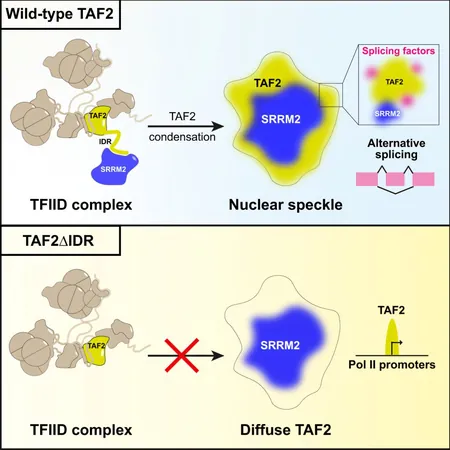
Unlocking the Secrets of Gene Expression: A Flexible Protein’s Role in RNA Processing
2025-05-14
Author: Ming
Revolutionary Insights into Gene Expression
A groundbreaking study from the University of Freiburg, published in Cell Reports, unveils the pivotal role of a disordered protein segment in connecting gene transcription with RNA processing. Researchers focused on TAF2, a crucial component of the general transcription factor TFIID, and revealed that its intrinsically disordered region (IDR) serves as a dynamic positioning signal within the cell nucleus.
The Game-Changing Role of Intrinsically Disordered Regions (IDRs)
This research shines a spotlight on how flexible protein regions like TAF2's IDR organize molecular processes and could act as vital regulators of specific functions. These regions may be integral in targeting nuclear speckles, which are crucial for RNA processing, and their involvement raises intriguing questions about their role in disease mechanisms.
Dynamic Movement Across Nuclear Compartments
Under the leadership of Dr. Tanja Bhuiyan, the study demonstrated that the IDR directs TAF2 from active gene promoters, where transcription begins, to nuclear speckles—unique compartments chock-full of RNA-processing factors. Using cutting-edge techniques such as advanced imaging and proteomics, the team discovered that TAF2 dynamically shifts between various nuclear sites to perform different functions based on its location.
A Subtle Regulation of Gene Expression
Dr. Bhuiyan noted, "Our findings suggest that TAF2 functions beyond just promoting gene activation. This unique flexible region allows it to navigate between compartments, leading to interactions with RNA-processing machinery that ultimately shape gene expression outcomes." The research identified three functional pools of TAF2 in the nucleus, each associated with different molecular partners. When the IDR was removed, TAF2 became mislocalized, enhancing its presence at gene promoters while undermining its role in RNA processing.
From Gene Activation to RNA Processing: A New Paradigm
The findings indicate that TAF2 does not merely toggle gene expression on or off. Instead, it fine-tunes the RNA processing steps—a more nuanced yet impactful approach to regulation, as emphasized by Prof. Dr. Sebastian Arnold. This evolving knowledge reshapes our understanding of how cells masterfully coordinate complex molecular activities based on spatial dynamics.
The Significance of Flexible Protein Regions in Cellular Processes
As scientists continue to investigate the significance of IDRs, once thought to be structurally ambiguous, these flexible regions are now acknowledged as pivotal in forming biomolecular condensates and regulating functional specificity. The conserved elements within TAF2's IDR suggest that these targeting mechanisms could be foundational principles in nuclear gene regulation.
Implications for Health and Disease
While the study did not directly link its findings to diseases, the alternative splicing processes influenced by TAF2 touch on genes vital for neurodevelopment and membrane transport. This opens a Pandora's box of possibilities regarding TAF2's spatial dynamics and their effects on cell identity and stress responses, hinting at potential implications in various pathological conditions.


 Brasil (PT)
Brasil (PT)
 Canada (EN)
Canada (EN)
 Chile (ES)
Chile (ES)
 Česko (CS)
Česko (CS)
 대한민국 (KO)
대한민국 (KO)
 España (ES)
España (ES)
 France (FR)
France (FR)
 Hong Kong (EN)
Hong Kong (EN)
 Italia (IT)
Italia (IT)
 日本 (JA)
日本 (JA)
 Magyarország (HU)
Magyarország (HU)
 Norge (NO)
Norge (NO)
 Polska (PL)
Polska (PL)
 Schweiz (DE)
Schweiz (DE)
 Singapore (EN)
Singapore (EN)
 Sverige (SV)
Sverige (SV)
 Suomi (FI)
Suomi (FI)
 Türkiye (TR)
Türkiye (TR)
 الإمارات العربية المتحدة (AR)
الإمارات العربية المتحدة (AR)